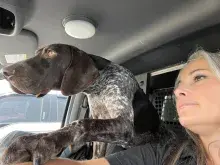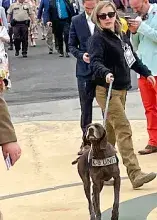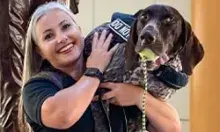 Canine Officer Xena, “Warrior Princess” and her partner, LaGuardia Airport Lead Explosives Detection Canine Handler Tatiana Rotaru. (Photo courtesy of Tatiana Rotaru)
Canine Officer Xena, “Warrior Princess” and her partner, LaGuardia Airport Lead Explosives Detection Canine Handler Tatiana Rotaru. (Photo courtesy of Tatiana Rotaru)
Editor’s note: The Day in the Life speaker series, produced by the Women Excel @ TSA (WE) Leadership Development Subcommittee, is a one-hour panel discussion with subject matter experts who share their insights into what makes their jobs fulfilling, their personal path to success and how they handle day-to-day responsibilities and challenges. With an eye on spurring career growth, each panel explores a different job and offers a Q&A session for tips on getting ahead in a specific field.
When George Bush Intercontinental Airport (IAH) Explosives Detection Canine Handler (EDCH) Denise Smith joined fellow panelist LaGuardia Airport (LGA) Lead EDCH Tatiana Rotaru to talk about their dream jobs, they were quick to say what the job isn’t – handlers don’t play with dogs all day.
Having a canine coworker does kick the joy factor up a notch, though.
Because the dogs are cared for and live with their handlers, the job requires a 24/7 commitment most other TSA jobs don’t have, which is why the characteristics of a successful EDCH include flexibility, dedication and persistence.
“It's work, and coming to work every single day is rewarding for me,” said Rotaru. “I absolutely love my job.”
"It’s a lot of sacrifice, but it’s the best position I’ve ever had,” said Smith. “It’s so much more fun working with a dog.”
The day starts at home
For Rotaru and her canine partner, Xena “Warrior Princess”, the day starts at 2 a.m. with Xena’s first feeding and a walk. Then they jump in a work truck and arrive at the airport for the 3:30 shift, meeting up with other LGA canine teams for training scenarios with rolling bags and decoys. Rotaru takes notes on Xena’s performance before the pair head to their screening assignments.
“We are responsible for a certain amount of time on leash (screening),” said Rotaru. We’re on public side screening baggage at curbside or we can be at the checkpoint screening passengers.”
“We support operations,” explained Smith about the job she and her male German shorthaired pointer, Will, perform. “Beyond the checkpoint, we are an additional
layer of screening for passengers.”
Different career paths, same dedication
The road to Smith’s EDCH job is textbook. A dog owner for 25 years, it’s not surprising one of her first jobs was pet sitting. Handling a variety of breeds gave her career direction and led to work in veterinary hospitals as a vet tech. She also dabbled in breeding and showing dogs.
Even with all that experience, Smith, who onboarded as a part-time TSO at Tampa International Airport in 2007, didn’t walk into the job on her first try.
“I applied for five years,” recalled Smith. “It took some time.”
Unlike Smith, Rotaru had very little handler experience. Joining the agency as a TSA officer in 2015 at Newark Liberty International Airport, Rotaru credits her rise to Lead EDCH to her curiosity.
“I started as an officer, and right away, within the first two months, I started looking at how I could do more,” said Rotaru. “I was ambitious and stayed persistent and committed to learn more about the agency.”
Intensive training
No matter what experience an EDCH has going into the position, they’re well prepared after an extensive four-month training at Lackland Air Force Base outside of San Antonio, Texas, and another four or five-months of on-the-job training at the airport.
TSA canines are single purpose dogs trained to detect explosives.
“What our dogs do is some of the hardest training, some of the hardest testing,” said Smith. “We test every year, and then we’re also tested at our own airport. That’s because our dogs are passenger screening canines. It’s an additional skill that no other private sector entity has most dogs in.”
Biggest challenges
Rotaru’s biggest EDCH challenge to date was at Lackland in 2019. She was paired with a very strong dog, and after the first day, her hand was swollen from holding the leash. When instructors offered to give her another dog, she politely declined.
“I put my foot down and said, ‘No, I will be working this dog,’” said Rotaru. “I’m going to show him who the alpha is. The biggest challenge was getting through the program, but I did. We built a rapport and became Top Dog (in the training class).”
“It's the rapport the handler has with the dog that lets the handler know what's going on and what the dog is reacting to,” added Smith. “Prioritizing and balancing the health and well-being of a dog and the needs of the operations can be very challenging.” The 24/7 responsibilities of work and caring for her canine partner is her biggest challenge.
Advice for aspiring handlers – be flexible
“Listen to the trainers and don’t ever argue,” said Rotaru. “They know best. Be flexible and open-minded. You may be called for different events, or you may be dispatched to different locations, so always take what is given with an open mind.”
Smith agreed. “I would say if you want to be a handler, you need to kind of be flexible. I know they do a hiring pool twice a year, and then other airports will hire on top of that. So, always keep your eye out for that.”
She also suggested networking and finding as many mentors as you can. “If you can find somebody who is really open to teaching you everything they know, someone who loves to share their knowledge, then that’s the type of person you want to be around.”
Thinking back on her long journey to her dream job, Smith offers interested job seekers the most important tip she’s learned – stay persistent.
“I would say do not ever give up because it’s the best job in the world, and you’re going to love it.”
By Karen Robicheaux, TSA Strategic Communications & Public Affairs



